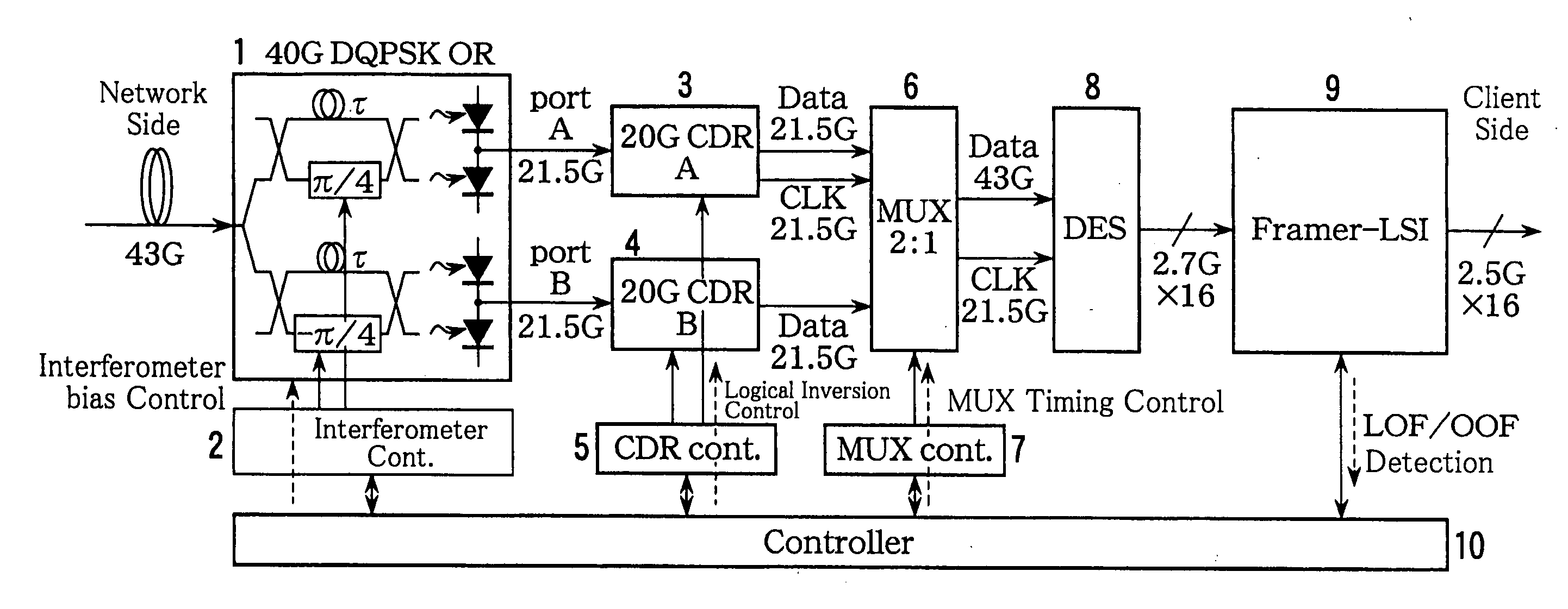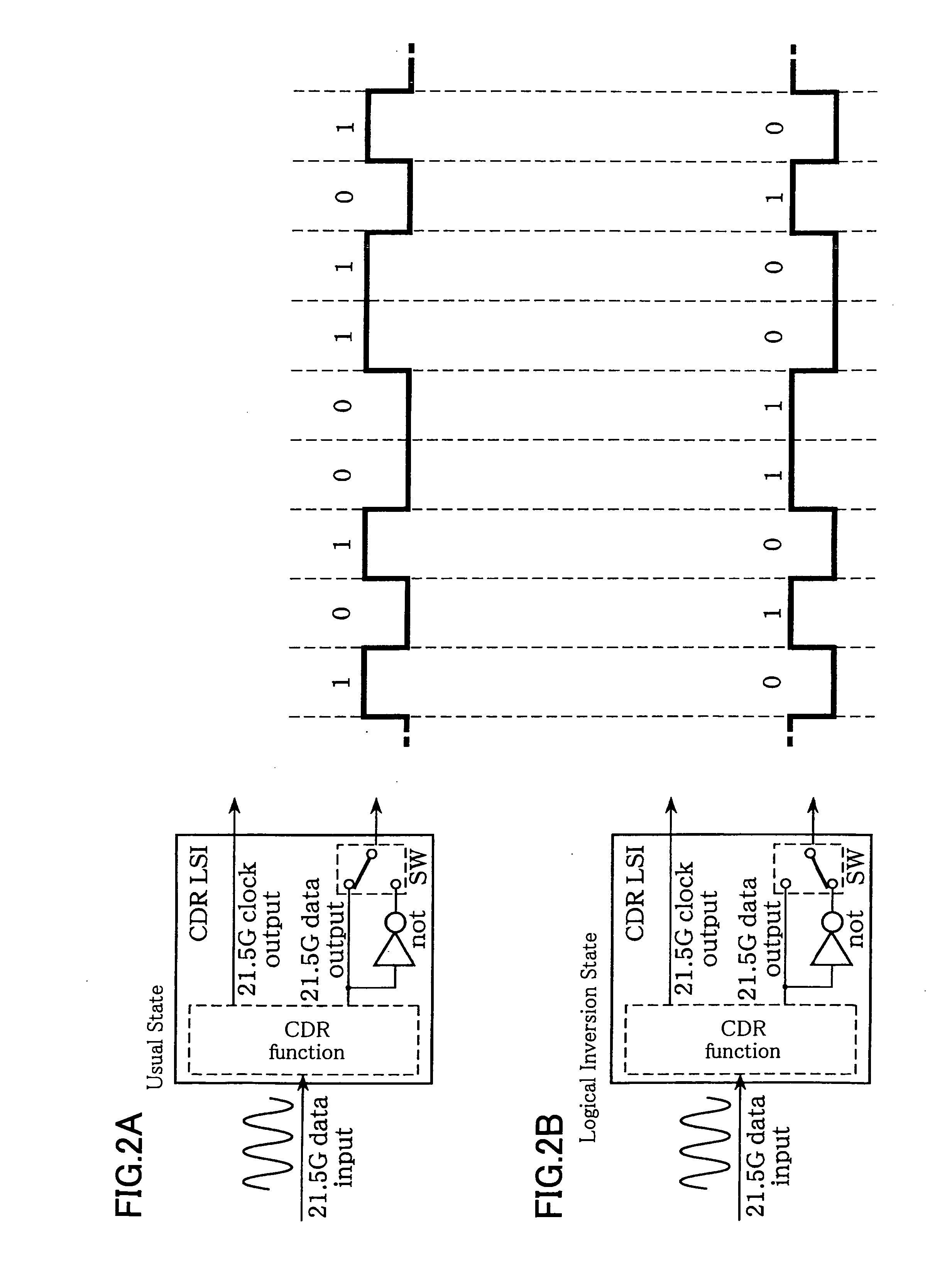Optical signal reception device and method of controlling optical signal reception
a technology of optical signal and optical signal, applied in the field of optical signal reception, can solve the problems of degrading the waveform of optical signals, affecting the operation of components,
- Summary
- Abstract
- Description
- Claims
- Application Information
AI Technical Summary
Benefits of technology
Problems solved by technology
Method used
Image
Examples
first embodiment
[0138]FIG. 1A is a block diagram illustrating a principal portion of an optical signal receiver according to a first embodiment of the present invention, used in an optical communication system for transmitting the DQPSK optical signals.
[0139]The optical signal receiver illustrated in FIG. 1A includes a front end 1 that has two delay interferometers and opto-electric conversion elements that receives DQPSK optical signals and converts the DQPSK optical signals into in-phase signals I and quadrature-phase signals Q; clock and data recovery 3 and 4 that regenerate clock and data signals based on the in-phase signals I and the quadrature-phase signals Q; a multiplexer 6 that multiplexes the in-phase signals I and the quadrature-phase signals Q output from the clock and data recoveries 3 and 4; a reception frame processing unit 9 that detects frame synchronization based on the signals multiplexed by the multiplexer 6; and a controller 10 that, based on an out-of-frame-synchronization de...
second embodiment
[0159]FIG. 4 is a block diagram illustrating a principal portion of an optical signal receiver according to a second embodiment of the present invention; specifically, FIG. 4 illustrates a principal portion of the reception frame processing unit 9 (framer LSI) as shown in FIG. 1A.
[0160]As illustrated in FIG. 4, the reception frame processing unit 9 includes a frame processor 21, a frame synchronization circuit 22, and a signal reception state identifier 23 for identifying signal reception states of DQPSK signals.
[0161]In addition, 16 parallel signals each at 2.7 Gbps are input to the reception frame processing unit 9.
[0162]The frame synchronization circuit 22 includes 16 frame synchronizers FSC01 through FSC16, which perform frame synchronization detection on different combinations of synchronization bit strings. In an OTN (Optical Transport Network) signal, as recommended by ITU-T G.709, it is known that a header of a frame is identified by detecting a Frame Alignment Signal (FAS) ...
third embodiment
[0173]FIG. 6 is a block diagram illustrating a principal portion of an optical signal receiver according to a third embodiment of the present invention; specifically, FIG. 6 illustrates a principal portion of the reception frame processing unit 9 (framer LSI) as shown in FIG. 1A.
[0174]As illustrated in FIG. 6, the reception frame processing unit 9 includes a frame processor 21a, a frame synchronization circuit 22a, an OTUk-FAS detection circuit 25, and registers 26. The same as FIG. 4, 16 parallel signals each at 2.7 Gbps from the de-serializer (DES) 8 are input to the reception frame processing unit 9.
[0175]The frame synchronization circuit 22a detects predetermined synchronization bits to detect frame synchronization, and sends a frame synchronization signal to the frame processor 21.
[0176]In OTN (Optical Transport Network) systems, as recommended by ITU-T G.709, Frame Alignment Signal (FAS) bytes are defined as the frame synchronization bits in an overhead section of an OTU signa...
PUM
 Login to View More
Login to View More Abstract
Description
Claims
Application Information
 Login to View More
Login to View More - R&D
- Intellectual Property
- Life Sciences
- Materials
- Tech Scout
- Unparalleled Data Quality
- Higher Quality Content
- 60% Fewer Hallucinations
Browse by: Latest US Patents, China's latest patents, Technical Efficacy Thesaurus, Application Domain, Technology Topic, Popular Technical Reports.
© 2025 PatSnap. All rights reserved.Legal|Privacy policy|Modern Slavery Act Transparency Statement|Sitemap|About US| Contact US: help@patsnap.com



